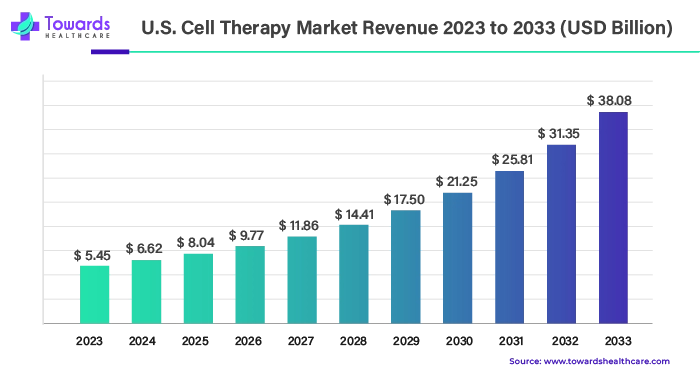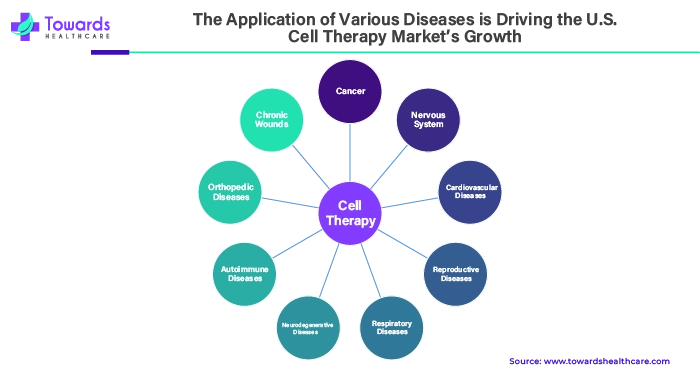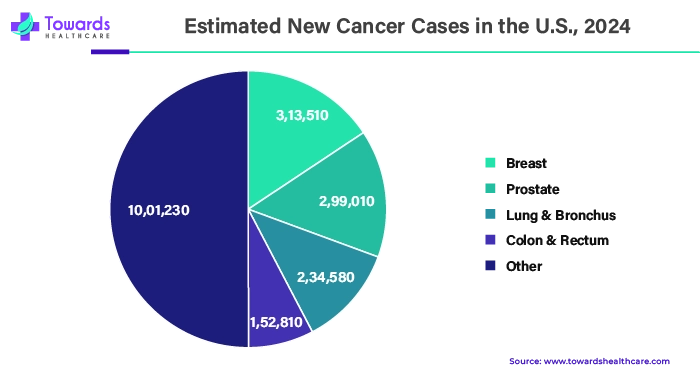April 2025

.webp)
Principal Consultant

Reviewed By
The U.S. cell therapy market size was valued at US$ 5.45 billion in 2023 and is projected to reach US$ 38.08 billion by 2033, registering a CAGR of 21.46% from 2024 to 2033. The increasing prevalence of chronic conditions is driving the growth of the market.

The U.S. cell therapy market encompasses research & development, therapeutics, medication, education, equipment, software, and different resources associated with cell therapy. Cell therapy is a type of treatment where a patient receives an injection, graft, or implant of live cells in order to have a therapeutic effect. It is also known as cellular therapy, cell transplantation, or cytotherapy. The most widely used and proven cell transplantation therapy is bone marrow transplants. Treatments for cancer, autoimmune illnesses, infections, urinary issues, spinal cord injuries, rebuilding damaged joint cartilage, strengthening immunocompromised people, and neurological disorders are among the potential uses of cell treatments. Hospitals, clinics, biotechnology, research & development, pharmaceutical, and educational sectors are among the main industries contributing to the growth of the U.S. cell therapy market. The future growth of the market is being aided by research and development, treatment customization, and technological improvements.
| Company Name | Atara Biotherapeutics Inc. |
| Headquarters | California, U.S. |
| Pipeline |
In order to set the path for future therapies, the firm is making a lot of effort to address important unmet needs in autoimmune disorders and cancer. Numerous cell treatments are being researched.
|
| Company Name | Gilead Sciences Inc. |
| Headquarters | California, U.S. |
| Pipeline |
List of cell therapies under development:
|

Cell therapies have applications in various diseases and are mainly used for cancer treatment. Numerous growth factors secreted by adult bone marrow stem cells allow them to develop into the type of cells needed to repair the heart and blood arteries. Stem cell treatment has the potential to promote the formation of new, healthy skin tissue, increase the synthesis of collagen, accelerate the growth of hair following cuts or hair loss, and help replace damaged or scarred tissue with newly formed, healthy tissue. According to recent developments in the treatment of conditions like Parkinson's and Huntington's, adult stem cells injected into the brain can aid in the regeneration of new brain synapses, neurons, and cells following brain trauma or cognitive decline. For those suffering from severe and incapacitating autoimmune disorders like lupus and rheumatoid arthritis, stem cell treatment offers fresh hope. Patients suffering from pain connected to sports injuries, spinal disorders, and orthopedic issues might benefit from this therapy. As these diseases grow in the U.S., the demand for the U.S. cell therapy market is increasing.
For instance,
Among the costliest treatments available is cellular and gene therapy. Concerns regarding the affordability and accessibility of cell therapies for patients, payers, and healthcare systems both domestically and internationally are raised by their high cost—typically over $400,000 US$ and occasionally over $1 million USD per patient and technical difficulties. Additionally, the cost of cell therapy may put a strain on healthcare budgets, requiring governments and insurers to make difficult choices about how best to allocate resources and cover various products. One reason for the high cost of cell therapy is the expenses associated with its production and administration. Leukapheresis is the first stage in the multistep cell manufacturing process. Next, T cells are obtained by genetic engineering, which uses viral vectors or nonviral ways to add CAR expression. Finally, the transformed T cells are expanded in a controlled environment. Each of these procedures may need specialized tools, knowledgeable staff, and stringent quality assurance protocols.
CAR-T cell therapy is one of the newest and most promising therapies available for blood cancer. These treatments aid in the battle against cancer by using your body's immune system. When the first CAR-T cell drugs were discovered, Penn Medicine was a trailblazer. CAR T-cell therapy has a number of benefits that make it extremely promising for the treatment of cancer in the future. Certain malignancies have been effectively treated using CAR-T cells, especially blood cancers like lymphoma and leukemia. CAR T cells are designed to target a particular antigen present in cancerous cells. This customization lessens adverse effects and minimizes damage to healthy tissues. CAR T cells are designed to proliferate and endure inside the body. This implies that they may provide sustained defense against the return of cancer.
For instance,
By therapy type, the autologous segment dominated the U.S. cell therapy market in 2023. The first step in autologous cell treatment is usually to remove tissues or cells from the patient, such as bone marrow or blood. Autologous cell treatments include autologous skin grafting, autologous CAR T cell therapies, and platelet-rich plasma therapy. Autologous methods have the important benefit of reducing the danger of immunological rejection in patients and fostering long-term recovery. There are fewer adverse effects and a greater likelihood of success when the risk profile is favorable. Additionally, patients receiving autologous cell treatments have access to customized therapy choices, which enables more focused and efficient interventions. Cardiovascular disorders can be effectively treated using autologous cell treatments, cancer, neurodegenerative illnesses and orthopedic problems.
For instance,
By therapy type, the allogenic therapies segment is estimated to grow at the fastest CAGR during the forecast period. Various advantages of allogenic cell therapies are boosting the growth of the segment in the U.S. cell therapy market. The fact that there are several possible cell sources for allogeneic cell therapy, such as donated tissues, bone marrow, induced pluripotent and embryonic stem cells, placenta, and umbilical cord blood, is advantageous. Patients with Sezary syndrome, myelodysplastic syndrome, acute myeloid leukemia, and cutaneous T cell lymphoma may benefit from allogeneic stem cell transplantation (Allo-SCT).
Convenient regeneration therapeutics are drawing interest in allogeneic adult stem cells. They provide an answer to resistive barriers in allogeneic therapies because they may be designed to elude the recipient's immune system. Mesenchymal stem cell treatment, hematopoietic stem cell transplantation, induced pluripotent stem cell therapy, and chimeric antigen receptor T cell therapy are a few examples of allogeneic cell therapies.
For instance,
By therapeutic area, the oncology segment dominated the U.S. cell therapy market in 2023 and is expected to remain dominant during the forecast period. A promising new treatment in the battle against cancer is stem cell treatment, which encompasses all operations involving stem cells. Because it improves the target of tumors, it may increase the therapeutic effectiveness of other medicines while lowering off-target occurrences. Preclinical trials have examined a wide range of stem cell-based approaches, demonstrating both considerable promise and difficulties in the treatment of cancer. Stem cell therapy has been used to produce a number of cancer treatment options, such as HSC transplantation, MSC infusion for post-cancer treatment, stem cells as therapeutic carriers, the creation of vaccines, and the development of immune effector cells. Numerous blood malignancies have already received approval for cell treatments, and it is believed that many other tumors may benefit as well. Cell treatments can be designed to target and eliminate tumor cells that have certain genetic abnormalities, sparing healthy cells from harm.

For instance,
By Therapy Type
By Therapeutic Area
April 2025
March 2025
March 2025
March 2025